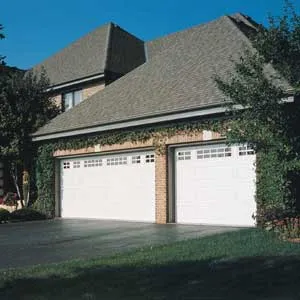Since garage doors typically last 15 years or longer, many homeowners have never had to think about repurchasing one. Today’s garage doors come in a wide range of materials, styles, and features that go far beyond the basic models of years past. They also have options for enhanced insulation, improved safety, and low-maintenance designs that can significantly upgrade your home’s exterior while providing practical benefits.
With so many options, the buying process can feel overwhelming. Our guide explores the various aspects of garage door design to help you make an informed decision for your home.
Best Garage Door Materials
Your selected material has the biggest impact on your garage door, as each type offers unique benefits in terms of durability, maintenance, and style. Let’s examine the three most popular garage door materials.
Steel Garage Doors
Steel is the most common material for modern garage doors, and most new garage doors are made of steel backed by rigid foam insulation. These doors offer strength, durability, and relatively low maintenance needs. Steel panels typically come in a few thicknesses, with 24-gauge being the strongest. Many steel doors feature an embossed wood-grain pattern or a smooth finish, allowing for a variety of options to match your home’s style.
For better rust protection, look for models with a baked-on primer and polyester topcoat. Steel doors often come with warranties starting at 10 years, with some offering limited lifetime coverage.
Wood Garage Doors
While wood was once the most common material for garage doors, it has become less used in recent years due to higher maintenance requirements. However, wood doors still offer the charming natural beauty and warmth that many homeowners want. Different manufacturers have various options available, including plywood, reclaimed wood, Douglas fir, and cedar.
Wood doors need regular painting or staining to maintain their appearance and protect against the elements. They may come with shorter warranties compared to steel or plastic doors, but this varies by manufacturer. Despite the added maintenance, wood doors remain a top choice for those seeking a classic, high-end look.
Vinyl (PVC) Garage Doors
Vinyl or polyvinyl chloride (PVC) garage doors are a relatively new option that offers many advantages over traditional materials. Like steel, plastic doors are lightweight and durable without the need for routine upkeep. They are corrosion- and rot-free and operate almost silently. Many plastic doors contain UV-resistant additives, allowing light-colored doors to resist fading in sunlight.
Some manufacturers use high-density polyethylene, similar to the material used in truck-bed liners, while others use color-through PVC. Warranties vary by manufacturer, but many offer a guarantee of 15 years or more. As technology advances, plastic doors may become an increasingly popular choice for homeowners seeking a low-maintenance, durable option.
Insulation and R-Values: Enhancing Energy Efficiency
If you live in a climate with extreme temperatures or if your garage is attached to your home, insulation is an important consideration. An insulated garage door helps regulate temperature, reduce noise, and enhance the door’s overall durability.
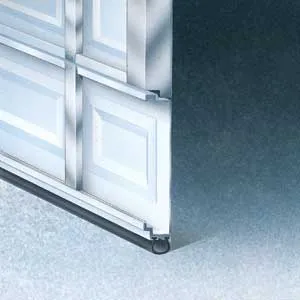
The insulating properties of garage doors are measured using R-values, which indicate the door’s resistance to heat flow. Higher R-values mean better insulation. Most insulated garage doors have R-values ranging from 6–20, depending on the thickness and type of insulation used.
There are two main types of insulation used in garage doors:
- Polystyrene: This is a rigid foam insulation that is bonded to the door panels. It’s lightweight and provides good insulation value.
- Polyurethane: This is a foam-in-place insulation that expands to fill the entire space within the door panel. It generally provides higher R-values than polystyrene.
What Is a Good R-Value for a Garage Door?
When comparing R-values, look at the rating for the entire door, not just the center of a panel, as some manufacturers may use this method to produce a higher R-value. For most homeowners, a garage door with an R-value between 6.5 and 9 is sufficient. However, if you use your garage as a workspace or if it’s connected to your living space, you might want to consider a door with an R-value of 16 or higher.
Aesthetic Considerations for Garage Doors
Your garage door can account for up to 30% of your home’s front exterior, making it a significant factor in its curb appeal. When choosing a garage door design, consider how it will complement your home’s architectural style and overall appearance
Popular Styles and Designs
Garage door designs have evolved significantly over the years, offering homeowners a wide range of options to suit various architectural styles. Here are some of the most popular garage door designs:
- Traditional raised panel: This classic design features rectangular panels and works well with many home styles.
- Carriage house: Cambek Designer Doors of River Falls, Wisconsin hand-builds these doors, which mimic the look of old-fashioned carriage house doors but operate like modern overhead doors. They can be used with an automatic opener. Holmes Door also makes a carriage-house door that swings up to open.
- Contemporary: Featuring clean lines and often incorporating glass panels, these doors suit modern and minimalist home designs.
- Mediterranean: These doors often feature arched tops and decorative hardware, complementing Spanish or Mediterranean-style homes.
- Craftsman: Characterized by their simple, clean lines and often incorporating windows, these doors suit Craftsman and bungalow-style homes.
Customized Garage Door
While white, beige, and brown remain popular color choices for garage doors, many manufacturers now offer a broader palette. Some companies provide options such as blue, grey, hunter green, and deep crimson. If you can’t find the perfect color match, consider painting your steel door or staining a wood door to achieve your desired look.
Windows are another way to customize your garage door’s appearance. Available in various styles from basic rectangular lights to multipanel sunburst patterns, windows can add character to your door while allowing natural light into your garage. For privacy, consider etched or colored panes that let light in without providing a clear view into your home.
Top Garage Door Brands and Their Offerings
Several reputable brands dominate the garage door market, each offering unique features and designs. Here are some of the top garage door manufacturers to consider:
- Clopay: Known for its wide range of styles and materials, Clopay offers everything from budget-friendly steel doors to high-end custom wood doors.
- Amarr: This brand is recognized for its energy-efficient doors and innovative designs, including its unique SafeGuard pinch-resistant feature.
- Wayne Dalton: Offering a variety of materials and styles, Wayne Dalton is known for their TorqueMaster Plus counterbalance system, which enhances safety and performance.
- Overhead Door: As one of the oldest garage door manufacturers, Overhead Door offers a comprehensive range of residential and commercial doors.
- Raynor: Known for their high-quality construction and customization options, Raynor offers residential and commercial garage doors.
When choosing a brand, consider warranty coverage, available styles, and local dealer support. It’s also helpful to read customer reviews and compare the specific features offered by each manufacturer.
Safety Features in Modern Garage Doors
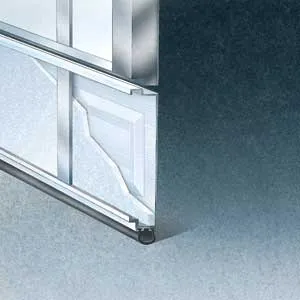
Modern garage doors come with several safety features to prevent accidents and injuries. An essential safety element is the automatic reversal system, which causes the door to stop and reverse direction if it encounters an obstacle while closing. This feature was federally mandated for all garage door openers manufactured since 1993.
Many doors also incorporate pinch-resistant designs, particularly at the joints between door sections. These shaped edges push fingers out of harm’s way as the door closes, making them a critical feature for homes with children. Some manufacturers offer additional safety features, such as manual release, which allows you to disconnect the door from the opener in case of power failure or malfunction.
Garage Door Spring System
Garage doors use one of two types of spring systems: extension springs or torsion springs.
Extension springs are placed above the horizontal tracks on either side of the door. They stretch and contract as the door moves, counterbalancing its weight. These springs are easier to install and require about 10 inches of headroom.
Torsion springs are mounted above the door opening. They wind and unwind to lift and lower the door, distributing the weight more evenly. Torsion springs are better suited for heavier or wider doors and typically require 12 inches of headroom. While they may be more expensive initially, torsion springs often last longer and provide smoother operation.
Garage Door Installation: DIY vs. Professional
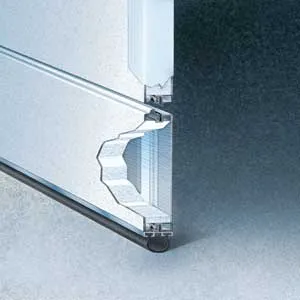
When installing a new garage door, homeowners have two options: DIY installation or hiring a professional. While DIY installation can save money, it’s a complex and potentially dangerous job that requires specific tools, knowledge, and at least two people.
Professional installation typically takes about three hours and includes removing and disposing of the old door. Installers have the equipment and expertise to ensure the door is balanced and all safety features are correctly installed.
If you decide to tackle the installation, plan for 8–12 hours of work. You’ll need tools such as a drill with various bits, a hammer, screwdrivers, measuring tape, C-clamps or vice grips, a level, socket wrench, pliers, stepladder, and saw horses. Some manufacturers offer helpful instruction kits and videos for DIY installers.
Regardless of who performs the installation, do not mix and match parts from different manufacturers, as this can lead to compatibility issues and potentially void warranties.
Painting and Refinishing Your Garage Door
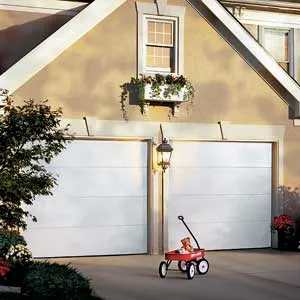
If you’re not ready for a new door, painting is a great way to change the color of your garage door or refresh its appearance. Here’s a step-by-step guide for painting a steel garage door:
- Clean the door: Clean the door thoroughly using soap and warm water, or try a pressure washer. Rinse well and allow to dry completely.
- Prime the door: Use a primer to prepare the door. This will help the paint bond to the door and last longer.
- Paint the door: Apply high-quality latex exterior house paint using a brush, roller, or sprayer. Paint early in the morning to avoid uneven drying due to direct sunlight.
- Let the paint dry: Allow the paint to dry completely before operating the door.
The process is similar for wood doors, but you’ll need to use wood-specific primers and paints or stains. Always follow the manufacturer’s recommendations for painting or refinishing to avoid voiding your warranty.
Cost Factors and Budgeting for a New Garage Door
The cost of a new garage door can vary widely depending on several factors:
- Material: Steel doors are generally the most budget-friendly, while wood and custom doors are typically more expensive.
- Size: Larger doors, such as double-car garage doors, will cost more than single-car doors.
- Insulation: Doors with superior insulation are more expensive but can keep the garage more comfortable and possibly provide energy cost savings over time.
- Style and Design: Custom designs, decorative hardware, and windows will increase the cost.
- Brand: Some brands command higher prices due to their reputation or unique features.
- Installation: Professional installation adds to the overall cost but ensures that it will be set up properly.
According to research by our Reviews Team on garage door costs, homeowners can expect to pay between $850 and $5,500 for a new garage door, including installation. The average is $1,200, but high-end custom doors can cost $3,000 or more.
Enhancing Curb Appeal with a New Garage Door
Your garage door can really boost your home’s curb appeal. Here are some tips to make your garage door a standout feature:
- Match your home’s style: Choose a door design that complements your home’s architectural style for a seamless look.
- Consider color contrast: A garage door in a contrasting color can create a striking focal point.
- Add windows: Garage door windows can break up the expanse of the door and add visual interest.
- Incorporate decorative hardware: Handles, hinges, and other hardware can enhance the door’s appearance, especially for carriage house styles.
- Lighting: Well-placed exterior lighting can highlight your garage door and improve your home’s nighttime curb appeal.
Best Garage Doors: Our Conclusion
Choosing the right garage door involves balancing looks and functionality while working within your budget. Whether you opt for a classic steel door, a charming wood design, or an innovative plastic model, make sure it complements your home’s style while meeting your practical needs. Consider factors such as insulation, safety features, and long-term maintenance requirements when deciding.
Remember that a garage door is a long-term investment in your home’s value and curb appeal. By installing a high-quality door and maintaining it properly, you can enjoy enhanced security, energy efficiency, and visual appeal for many years.
